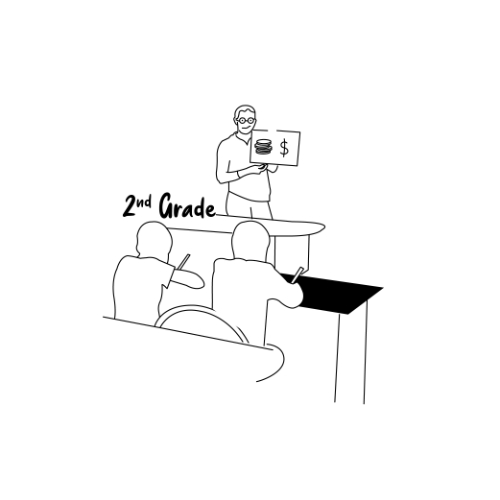Your 2nd-grade students are well on their way to understanding basic financial concepts. They know what money is, its value, and the differences between various coins and bills. As they expand their economic knowledge base, you can focus on the primary topics of this grade: opportunity cost, natural resources, human resources, capital resources, currency, price, and income. If you need top-of-the-line, ready-to-rock lesson plans that hit these concepts, head over to 2nd grade money lesson plans page to download all your 2nd-grade class prep needs.
If you need additional support to help shore up your students’ financial education, you can go with activities, games, printables, and other resources geared towards the 2nd-grade level. These types of exercises are outstanding for reviewing core concepts and enhancing your students’ learning, especially about handling money. Whether kids engage in online games, interactive sites, board games, or worksheets about money, they will benefit from them, having fun and learning a lot in the process. Let’s take a look at the best 2nd-grade money activities and games.
Dollars and Cents
This game is a fun activity of matching, where students concentrate on cards labeled with different denominations, both in word form and numbers. As they flip over cards, they have to remember where the matching pairs were, helping them to increase their focus, number awareness, and understanding of financial terms.
Foreign Currency Collection
Wait, a combination of math, writing, and geography all rolled into one? It’s true. With this activity, your 2nd-graders research international countries, identify the currency they use, color the country on the map, and even find exchange rates, tying many subjects into one activity and providing kids the chance to learn more about their world.
Catch the Coin Game
Teachers have their students sit across the table from them, ready to play the game. Adults slide various coins across the surface, having kids name the coin type (penny, nickel, dime, or quarter) before it falls off the table. This game is an exciting way to learn different denominations as they feel the positive pressure to get the answer right.
Do You Want to Battle?
In this game, kids play in pairs, each with a large pile of coins they need to identify and say which is which. Students pull one coin at a time, “battling” to see who has the highest value compared to their competitor, and the winners keep the coin in their piles.
Apple Counting Money Game
In this game, students try to draw card stock apples with various money amounts, adding to their totals as they accumulate apples by going around the board. It is a simple but fun game that engages students as they learn and count money while they race to finish with the most cash.
Going on a Coin Hunt
Teachers and homeschoolers can print out these worksheets, consisting of fourteen eggs of different shapes. As students search around the room for real eggs – with coins inside – they match the corresponding money amount to the forms on their sheets, making for a great activity to play and build money knowledge.
Money Smarts Math Game for Kids
This simple yet effective board game combines several critical money concepts, including counting, reading comprehension, and the idea of putting your money into different categories. Learners use Spend, Save, and Give jars to allocate the money they win during gameplay, helping students see the importance of thinking intentionally about the cash they receive.
Discovering Money Lapbook
You can choose between several mini-books and worksheets (found here) to create a customized lapbook for your students to learn about money. It is like having a compact encyclopedia at their fingertips, with topics like coin identification, equal amounts, ways to count with different coins, and more.
Candy Shop
This worksheet activity is similar to a Scrabble game, where each letter kids use to spell out specific candy words is worth a set amount of money. They total up how many coins they got, helping strengthen their math, spelling, and coin denomination awareness.
Caterpillars
Many kids love caterpillars, and you can capitalize on this interest with this game, which involves counting cash and identifying pennies, nickels, and more. Teachers can use real coins or cut out paper versions and have students try to total amounts you instruct.
Coin Counting Piggy Bank Clip Cards
These clip cards appeal to students because of their funny pig images and require them to use their newfound money skills to solve math problems. They clip their clothespins on the correct answer shown on the card, so students have a unique way to answer and demonstrate their understanding.
Safari Spelling Words
Teachers can create these cards fairly quickly, providing students an exciting and competitive game to play with their classmates. You can find images of animals you may see on safari, paste them onto a card, and create tiles worth cents (1 cent for pennies, 5 cents for nickels, and so on), and students total them on the card. Kids love animals, and teachers will love the engaging play cards to keep them totaling their money.
Coin Sorting Mats
You can create mats out of different materials with various coins on them, giving you a straightforward activity you can use anytime. Students get a pile of cash, identify the various types of currency, and sort them according to their denomination, giving students valuable practice and hands-on experience with money.
Task Cards – Making Change
These task cards allow students to level up their money math skills, where they make change from hypothetical toy-buying situations. Task cards are excellent for extending your core teachings about money management, letting students use their financial knowledge in realistic and fun circumstances.
Battleship Money Math Game
You can create game cards quickly for this activity or download them here, giving you a game that is easy to set up and simple to play. Your students will enjoy the Battleship-style setup, complete with grids and coordinates, and they will try to fill up their play cards as you announce money totals they need to reach and place coins.
The Money Game for Kids
This elaborate game is sure to be a hit with your 2nd-grade students. It combines elements of familiar board games with money-managing habit-building activities. Teachers will love the various skills they can build up with their kids, including creative thinking, organization, arithmetic, and financial savviness.
Ice Cream Activity
Educators will enjoy this activity, and so will their students, letting them pretend they get to make the ice cream sundae of their dreams and knowing the costs of their creation. You can create a virtual ice cream shop, handing out cards to all the kids, and they fill in the different toppings they want to order – along with the prices of each.
Mason Jar Activity – Spend, Save, Give
This DIY activity is a proven and time-tested approach to teaching kids about money management. It only requires some mason jars and labels. Students earn money in various ways and have to decide between three jars (which teachers can buy wholesale and students can label and decorate). Teachers can make the activity last for a day, a week, or the entire 2nd-grade year.
Money Boxes for Children
2nd-graders love to craft and can do just that with this fun, easy activity. Educators can have their students create simple money boxes to store cash they earn in class for various activities, decorate the boxes, and make them unique while learning how to hold their money securely.
Science Projects – Chemical Reactions with Pennies
The premise of this project is to turn pennies into different colors using lemon juice and vinegar, providing students a chance to practice science, learn about chemical reactions, and become very familiar with the coin. You can tie this activity into your money curriculum in multiple ways, including counting and sorting the different colors of pennies into stacks, making it a great exercise that spans subjects.
Money Toss-Up Activity
Kids can learn probability at a young age, and financially focused teachers can incorporate this concept into their class activities. Students use an easy-to-create chart to graph how many heads and tails were thrown with various coin denominations, and they calculate the probability and occurrence of coin tosses.
Skip Counting by 5s and 10s
Math is a central skill throughout school, and teachers can use realia to hammer down their lessons for kids. Skip counting is a vital ability for 2nd-graders to learn, and they can use nickels and dimes to begin working on this skill.
The Classroom Store
One activity that many kids will enjoy in classrooms everywhere is the classroom store. Teachers can provide objects for students to buy and label the different products with prices, and kids can earn money, save it in designated spots, and purchase whatever they want. They will learn valuable tools for their financial future, including saving, making wise purchasing decisions, and more.

